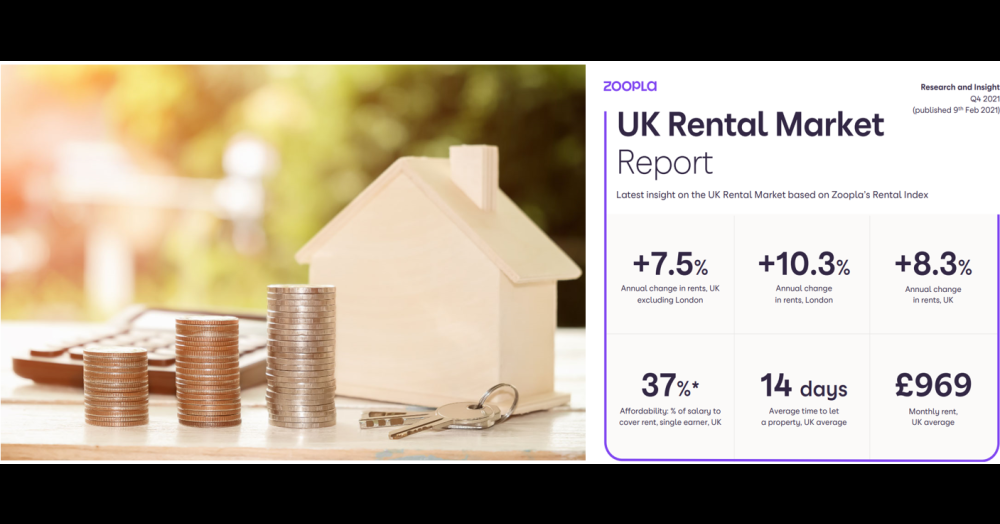See The Latest Zoopla UK Rental Market Report
Summary
• UK annual rental growth for new lets rises to +8.3% in Q4 2021 as demand gains momentum amid chronic shortage of supply
• Even so, rent as a proportion of a single earner income (37%) is still broadly in line with 10 year average (36%)
• London rents are up +10.3% on the year, but large falls in 2021 mean average rents are up just £18 a month since March 2020
• UK rental demand is up 76% in January compared to similar periods between 2018-2021
• Cumulative rental growth is 12% over the last 5 years, slightly under the rise in average hourly earnings over the same period
• As the demand peak falls back in coming months, less pressure on rental supply will create more competition in the market, and put the brakes on the scale of rental growth.
UK rental growth at +8.3%
Average UK rents rose 3.7% in Q4 2021 taking the annual rate of rental growth across the UK to +8.3%. This further rental growth was underpinned by a continued rise in rental demand, particularly in city centres, amid a chronic shortage of supply.
The average rent for the UK is now at £969 pcm, a new high, and £62pcm higher than at the start of the pandemic.
London leads the way in terms of rental growth, with a 10.3% annual rise. Even so, given the falls in London rents during the pandemic, as shown by the chart above, rents in London are only modestly above
where they were at the start of the pandemic. In March 2020, the average London rent was £1,622, and in December 2021, it had risen to £1,640.
Rents have risen in every other region and country in the UK, with growth ranging from 4.8% in Scotland to 10.2 % in Northern Ireland.
An analysis of asking rents over recent months suggests that much of the pandemic ‘rental recalibration’ took place during Q4., with an easing in asking rents during January. The change in rents has put upwards pressure on affordability levels in many regions, although they remain close to longer-run averages.
Zoopla’s measure of affordability – rent as a proportion of gross income - has averaged 36% for a single earner over the last decade. In December it rose to 37%. For those sharing with one other person, rent accounts for 18% of average income.
The headline affordability metrics suggest that rents could rise more before affordability becomes very stretched. There is flexibility in the rental market among those with more disposable income, who can adjust their rental expectations in line with their budget, choosing a slightly smaller property to lock in a
lower headline rent.
However any rises in rents will be felt most keenly by those on lower incomes who have less choice in the market. As demand continues to outstrip supply, there will be continued upwards pressure on rents.
However, landlords will be also considering these affordability metrics and how it might affect
demand in their market as they re-list any properties.
The scale of demand in January is clear from the chart below, with the New Year bounce resulting in demand being some 76% higher than the same month in the previous four years. However, demand is
already starting to ease back into February.
Demand surges in cities
Rental demand has gathered momentum in city centres over the last six months as the pandemic started to ease.
This time last year we were reporting the ‘halo effect’ as demand in wider commuter zones rose amid a ‘search for space’, but dipped in city centres amid consecutive lockdowns.
Now, demand has firmly bounced back in city centres as offices have re-opened, students have returned and the increased ease of global travel has allowed a release of pent-up international demand.
This has led to a strong rise in the annual rise in rents in these cities, with annual growth in rents in the inner cities outpacing the wider commuter zones for the first time since the start of the pandemic.
At the same time, supply in the rental market remains tight. Around 8% of previously rented properties were put on the sales market in H2, indicating that some landlords were looking to crystallise gains.
At the same time the level of investment into the rental market has been structurally reduced since the changes in stamp duty and taxes for landlords in recent years.
The current rise in rents for new tenancies may also persuade more renters to stay put in their current property and agree terms with their current landlord, again reducing supply in the market.
Outlook
As the January peak of demand eases into Q2, in line with seasonal trends, and also because of more renters deciding to stay put in the face of higher rents, putting less acute pressure on supply, we
expect the pace of rental growth to slow throughout 2022, with 4.5% rental growth across the UK excluding London, and 3.5% in London.
Landlords if you are looking for market advice call us now
01227 767200












